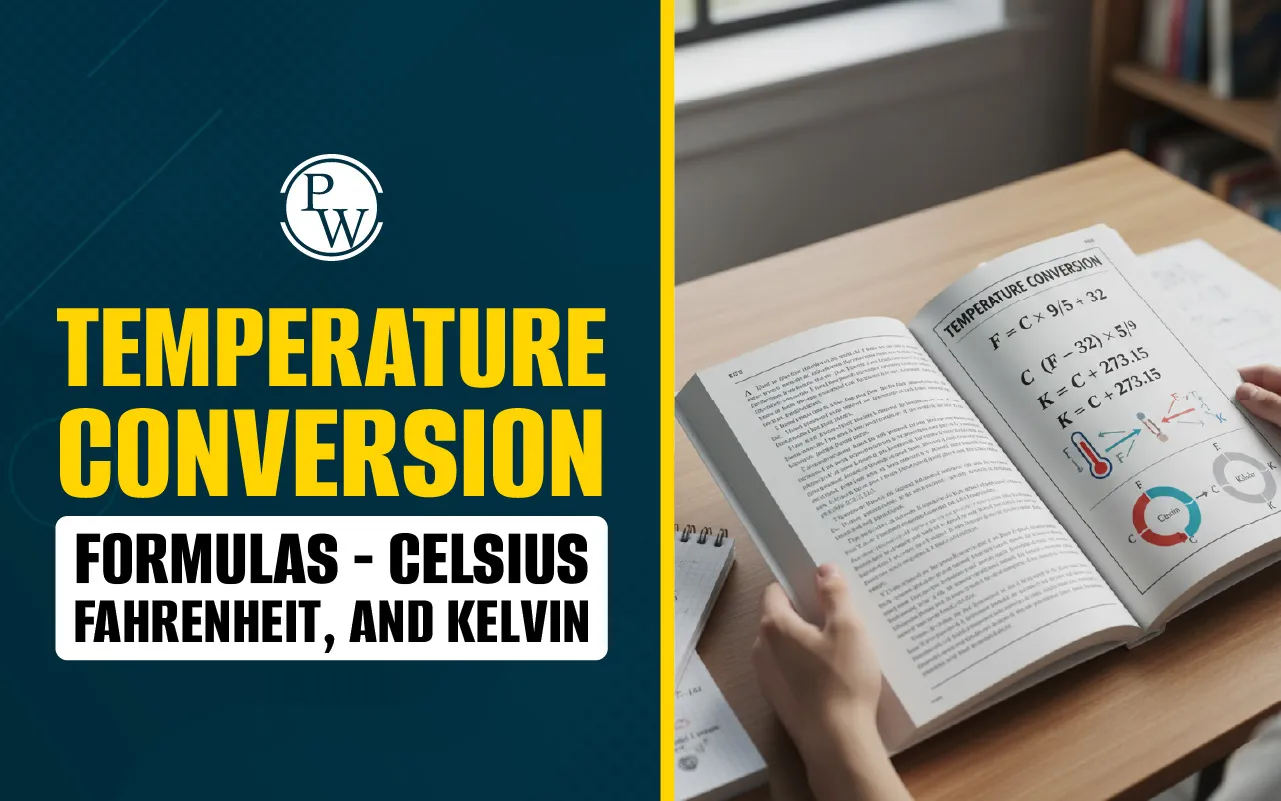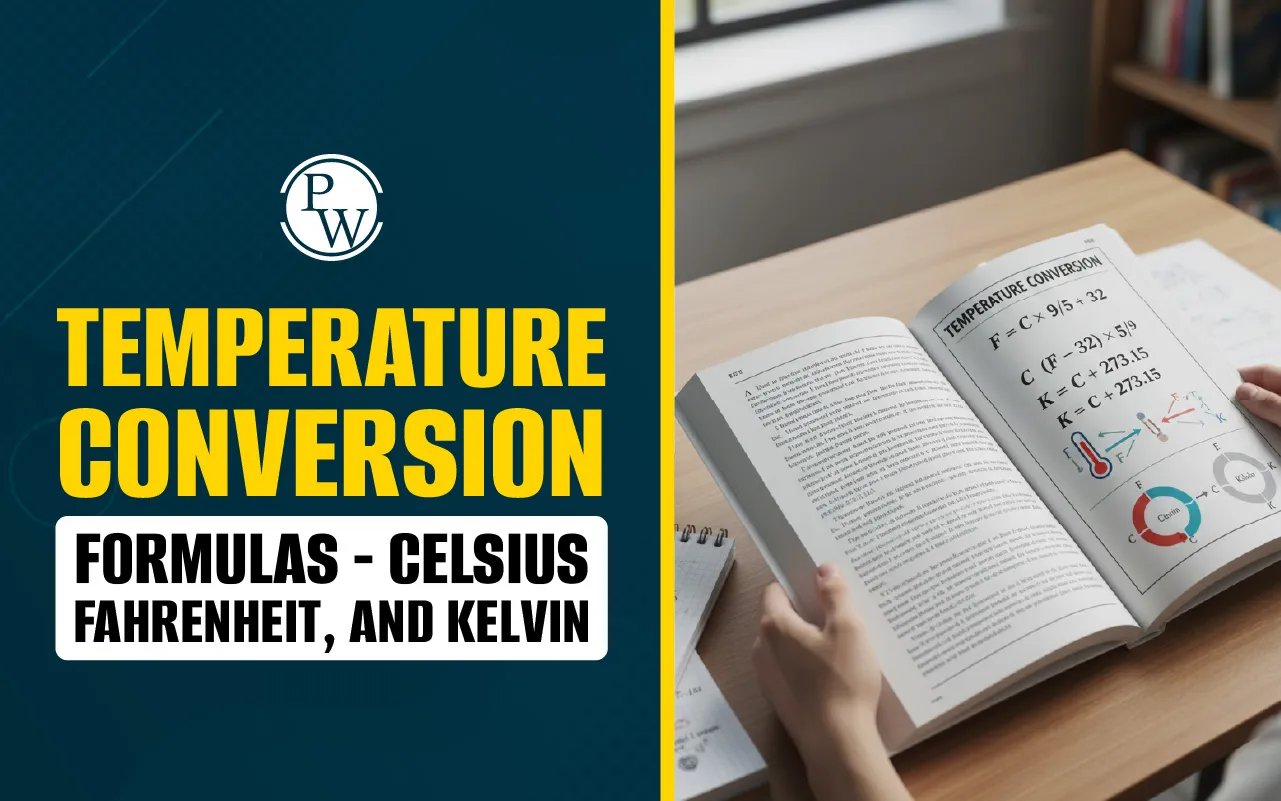

Temperature Conversion Formulas
Temperature conversion formulas are mathematical equations used to change a temperature reading from one scale to another. They allow conversion between Celsius, Fahrenheit, and Kelvin. These formulas are important because different countries and scientific fields use different scales. Using them, we can accurately compare or measure temperatures in daily life, weather reports, cooking, or scientific experiments.
What is Temperature?
Temperature tells us how hot or cold something is. It measures the energy of particles that make up matter. When particles move faster, the temperature increases, and when they move slower, the temperature decreases. For example:
-
When you boil water, the particles move very fast, and the temperature rises.
-
When you freeze water, the particles slow down, and the temperature drops.
To measure temperature, we use thermometers that display readings in one of three scales such as Celsius, Fahrenheit, or Kelvin. Understanding these scales helps us interpret temperature readings correctly, whether in science experiments, cooking, or daily life.
The Three Main Temperature Scales
The three main temperature scales used to measure heat and cold are Celsius, Fahrenheit, or Kelvin. Each scale works differently but serves the same purpose to show how hot or cold something is. Here we will learn about each of these in brief.
1. Celsius (°C)
The Celsius scale, also called centigrade, is used in most countries. It was created by Anders Celsius, a Swedish scientist. In this scale:
-
Water freezes at 0°C
-
Water boils at 100°C
This scale divides the distance between the freezing and boiling points of water into 100 equal parts, making it easy to read and calculate. Celsius is widely used for weather forecasts, cooking, and science learning in schools.
2. Fahrenheit (°F)
The Fahrenheit scale was developed by Daniel Gabriel Fahrenheit. It is commonly used in the United States and a few other countries. In this scale:
-
Water freezes at 32°F
-
Water boils at 212°F
Just like the Celsius scale, the difference between freezing and boiling points is divided into equal parts, but here it is divided into 180 parts. That’s why the same temperature looks like a larger number in Fahrenheit. For example, a pleasant summer day may be 25°C, but in Fahrenheit, it reads 77°F.
3. Kelvin (K)
The Kelvin scale is used mainly by scientists. It is based on the concept of absolute zero — the lowest possible temperature, where particles have no movement. In this scale:
-
0 K is absolute zero
-
Water freezes at 273 K
-
Water boils at 373 K
The Kelvin scale does not use degrees (°) before the K symbol. It’s mainly used in physics, chemistry, and astronomy.
Read More: What is 40 Degrees Celsius in Fahrenheit?
Why Do We Need Temperature Conversion?
Different parts of the world use different temperature scales. To communicate clearly, we need to convert between them. For example:
-
A weather report in the U.S. might say it’s 86°F. If you live in Australia, you will want to know what that is in Celsius.
-
In science class, you may have a reading in Celsius but need it in Kelvin for your experiment.
That’s why learning temperature conversion formulas is so helpful. These formulas let us switch between Celsius, Fahrenheit, and Kelvin quickly and accurately.
Celsius to Fahrenheit Conversion Formula
To convert Celsius to Fahrenheit, we use the Celsius to Fahrenheit formula:
°F = (°C × 95) + 32°F
This means you multiply the Celsius temperature by 9, divide by 5, and then add 32.
Example: Convert 25°C to Fahrenheit.
°F = (25 × 95) + 32
°F = 45 + 32
°F = 77
So, 25°C equals 77°F.
You can also call this the centigrade to Fahrenheit conversion, since Celsius is also known as the centigrade scale. This temperature formula is very handy for understanding weather differences between countries that use different systems.
Read more: Celsius to Fahrenheit Conversion
Fahrenheit to Celsius Conversion Formula
To convert from Fahrenheit to Celsius, use this temperature conversion formula:
°C= (°F − 32) × 59°C
Example: Convert 68°F to Celsius.
°C = (68 − 32 ) × 5/9
°C = 36 × 5/9
°C = 20
So, 68°F equals 20°C.
This formula helps you compare how much warmer or colder the temperature feels when switching from Fahrenheit readings to Celsius.
Celsius to Kelvin Conversion Formula
To convert Celsius to Kelvin, add 273 to the Celsius temperature.
K = °C + 273
Example: Convert 25°C to Kelvin.
K = 25 + 273
K = 298
So, 25°C equals 298 K
Kelvin is used in scientific work because it starts at absolute zero and does not include negative values.
Kelvin to Celsius Conversion Formula
To convert Kelvin to Celsius, subtract 273 from the Kelvin temperature.
°C = K - 273
Example: Convert 310 K to Celsius.
°C = 310 - 273
°C = 37
So, 310 K equals 37°C.
This temperature conversion is common in labs when working with chemical reactions or heat measurements.
Read More: Three States of Matter
Fahrenheit to Kelvin Conversion Formula
To convert Fahrenheit directly to Kelvin, use this two-step formula:
K = (°F - 32) × 5/9 + 273
Example: Convert 98°F to Kelvin.
K = (98 - 32) × 5/9 + 273
K = 66 × 5/9 + 273
K = 36.6 + 273
K = 309.6
So, 98°F equals 309.6 K.
This formula helps convert Fahrenheit readings directly into Kelvin without converting to Celsius first.
Kelvin to Fahrenheit Conversion Formula
To convert Kelvin to Fahrenheit, use this reverse formula:
°F = (K - 273) × 9/5 + 32
Example: Convert 300 K to Fahrenheit.
°F = (300 - 273) × 9/5 + 32
°F = 27 × 1.8 + 32
°F = 48.6 + 32
°F = 80.6
So, 300 K equals 80.6°F.
This temperature conversion is useful for scientists and engineers who work with precise temperature readings in research and design.
Temperature Conversion Reference Table
To make temperature conversion easier, it helps to have all the values in one place. The table below shows some common temperatures in Celsius, Fahrenheit, and Kelvin. You can use it as a quick guide to compare readings between the three scales without doing the full calculation each time.
|
Temperature Conversion Reference Table |
||
|
Celsius (°C) |
Fahrenheit (°F) |
Kelvin (K) |
|
0°C |
32°F |
273 K |
|
10°C |
50°F |
283 K |
|
25°C |
77°F |
298 K |
|
37°C |
98.6°F |
310 K |
|
100°C |
212°F |
373 K |
Tips for Remembering Temperature Formulas
Here are a few easy ways to remember the main temperature conversion formulas. These simple steps will help you convert between Celsius, Fahrenheit, and Kelvin quickly and accurately.
-
Celsius to Fahrenheit: Multiply the temperature by 9, divide the result by 5, then add 32 to get Fahrenheit.
-
Fahrenheit to Celsius: Subtract 32 from the temperature, multiply the result by 5, then divide by 9 to find Celsius.
-
Celsius to Kelvin: Add 273 to the Celsius temperature to get Kelvin.
-
Kelvin to Celsius: Subtract 273 from the Kelvin temperature to find Celsius.
-
Fahrenheit to Kelvin: Subtract 32, multiply by 5/9, then add 273 to get Kelvin.
-
Kelvin to Fahrenheit: Subtract 273, multiply by 9/5, then add 32 to find Fahrenheit.
Read More: Motion and Measurement of Distance
Temperature Conversion Formula Solved Examples
-
When the temperature of water is 25°C, what will it be in Fahrenheit? Also, if the temperature increases by 10°C, find the new temperature in Fahrenheit.
Solution:
Given: 25°C
Formula: °F = (°C × 9/5) + 32
= (25 × 9/5) + 32
= 45 + 32
= 77°F
If temperature increases by 10°C, new temperature = 25 + 10 = 35°C
Now, °F = (35 × 9/5) + 32
= 63 + 32 = 95°F
Initial temperature = 77°F
After increase = 95°F
-
The temperature of a city in the morning is 68°F. What is the temperature in Celsius? If the temperature drops by 5°C in the evening, what is the new temperature in Fahrenheit?
Solution:
Given: 68°F
Formula: °C = (°F − 32) × 5/9
= (68 − 32) × 5/9
= 36 × 5/9
= 20°C
Evening temperature = 20 − 5 = 15°C
Now convert back to Fahrenheit:
°F = (15 × 9/5) + 32
= 27 + 32 = 59°F
Morning temperature = 20°C (68°F)
Evening temperature = 15°C (59°F)
-
A scientist measures a chemical reaction at 300 K. What is this temperature in Celsius and Fahrenheit?
Solution:
Given: 300 K
Formula:
°C = K − 273
= 300 − 273 = 27°C
Now convert Celsius to Fahrenheit:
°F = (27 × 9/5) + 32
= 48.6 + 32 = 80.6°F
Temperature = 27°C or 80.6°F
-
At what temperature are Celsius and Fahrenheit readings equal?
Solution:
Let the temperature be x.
At this point, °C = °F = x.
Using the formula:
°F = (°C × 9/5) + 32 So,
x = (x × 9/5) + 32
Multiply both sides by 5 to remove the fraction:
5x = 9x + 160
5x − 9x = 160
−4x = 160
x = −40
Celsius and Fahrenheit readings are equal at −40°.
-
The temperature of a freezer is −10°C. Find its value in Kelvin and Fahrenheit.
Solution:
Given: −10°C
To convert Celsius to Kelvin:
K = °C + 273
K = −10 + 273
K = 263 K
To convert Celsius to Fahrenheit:
°F = (°C × 9/5) + 32
°F = (−10 × 9/5) + 32
°F = (−18) + 32
°F = 14°F
Freezer temperature = 263 K or 14°F
Fun Facts About Temperature
Here are a few fun and interesting facts about temperature that show how it changes from the coldest places on Earth to the hottest spots in the universe.
-
The coldest temperature ever recorded on Earth was −89.2°C in Antarctica.
-
The hottest temperature ever recorded was 56.7°C in Death Valley, USA.
-
The human body’s normal temperature is about 37°C, which is 98.6°F or 310 K.
-
On the Kelvin scale, temperatures never go below zero.
-
The Sun’s surface is about 5,500°C, or nearly 10,000°F.
Boost Your Child’s Math Skills with PW CuriousJr Online Classes
(Are you looking for a way to help your child enjoy and excel in Math from home? PW CuriousJr’s live online Math classes make learning interactive, engaging, and effective. With our expert teachers, children build confidence and problem-solving skills while having fun.)
Here’s what your child will get:
-
Live Interactive Classes: Learn Math concepts with games, examples, and shortcuts.
-
Personalized Mentoring: Small-group sessions ensure individual attention.
-
Daily Practice & Homework Support: Reinforce lessons and clear doubts easily.
-
Performance Tracking: Parents receive updates to monitor progress.
Our Math classes encourage critical thinking, make problem-solving easier, and help children apply what they learn in real-life situations. Start with a demo class for just ₹29 and watch your child gain confidence, improve skills, and enjoy learning Math every day!
